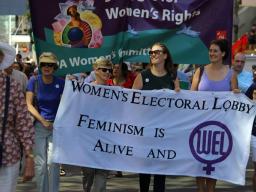The ARC Project
A three-year ARC Large Grant (No. A00104176) provided the funds for the WEL history project. The ANU and a number of individuals also provided financial assistance with publication of the book, while many members of WEL volunteered time and expertise.
The project assessed WEL’s significance as a policy actor and its attempts to shape the public agenda. It explored:
- WEL’s influence on government policy and how it was achieved; and
- The meaning of WEL for those involved and its impact on their lives.

WEL–Diamond Valley members marching with Women’s
Liberation, Melbourne, early 1970s.
Photo Sandy Turnbull (Kilpatrick).
Available on this website are:
- Research reports prepared by the project team, together with a photograph gallery; and
- A number of publications, papers and presentations. These include information about the book of the project, Making women count: a history of the Women’s Electoral Lobby in Australia, by Marian Sawer with Gail Radford, which was published by UNSW Press in 2008.
Work continued on the ANU WEL History after the publication of the book. Documents were archived, photographs and information were provided for publications and displays and papers were written. In 2014 the website was updated to include this new material.
WEL-New Zealand
It is important to note that this project concerned only WEL in Australia. While there were WEL groups in New Zealand in the years 1975-2004, their history has been written by Elspeth Preddy in her book The WEL Herstory: The Women’s Electoral Lobby in New Zealand 1975-2002. WEL-New Zealand and Fraser Books published this book in 2003.

WEL–NSW in International Women’s Day march Sydney,
8 March 2014, Photo Peter Boyle.
WEL-Australia’s activities today
For information about WEL’s activities today go to the WEL-Australia website. To receive regular updates by email on WEL’s activities (and other feminist news), you can subscribe to the e-Update by putting your details on the WEL subscribe page. You can also become a friend of the Women’s Electoral Lobby, Australia on Facebook and follow the Women’s Electoral Lobby on Twitter (WELA @welaust).

